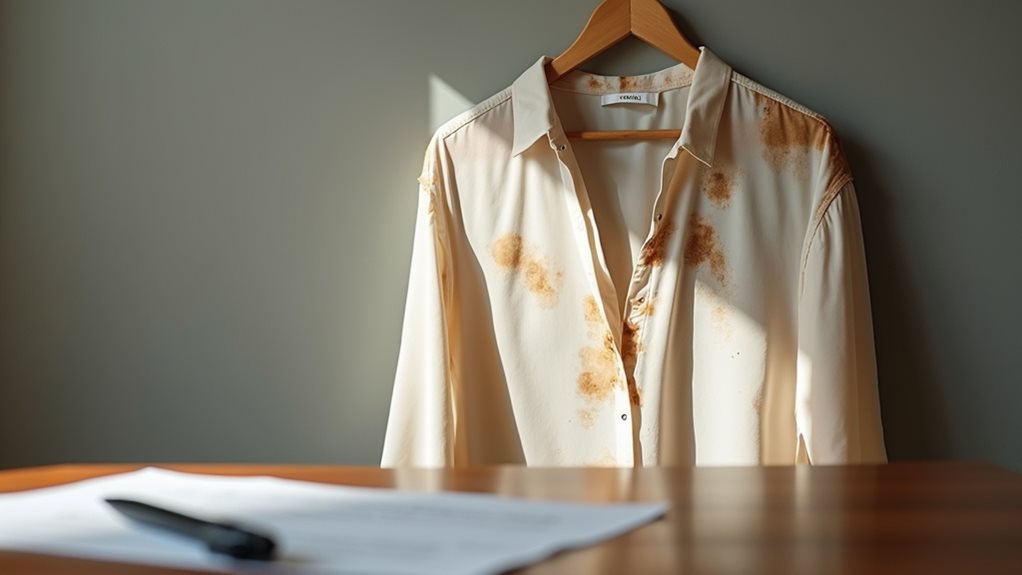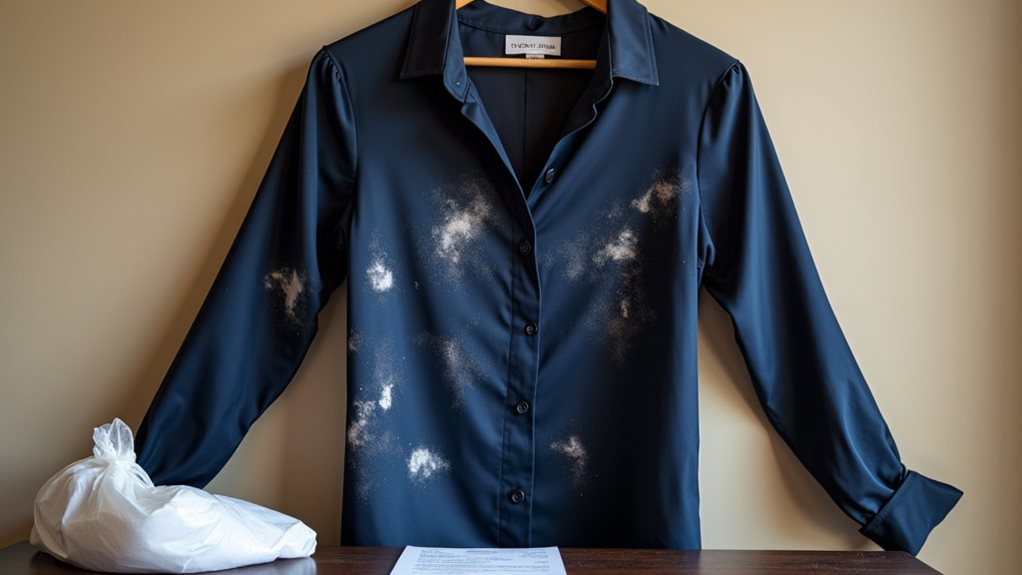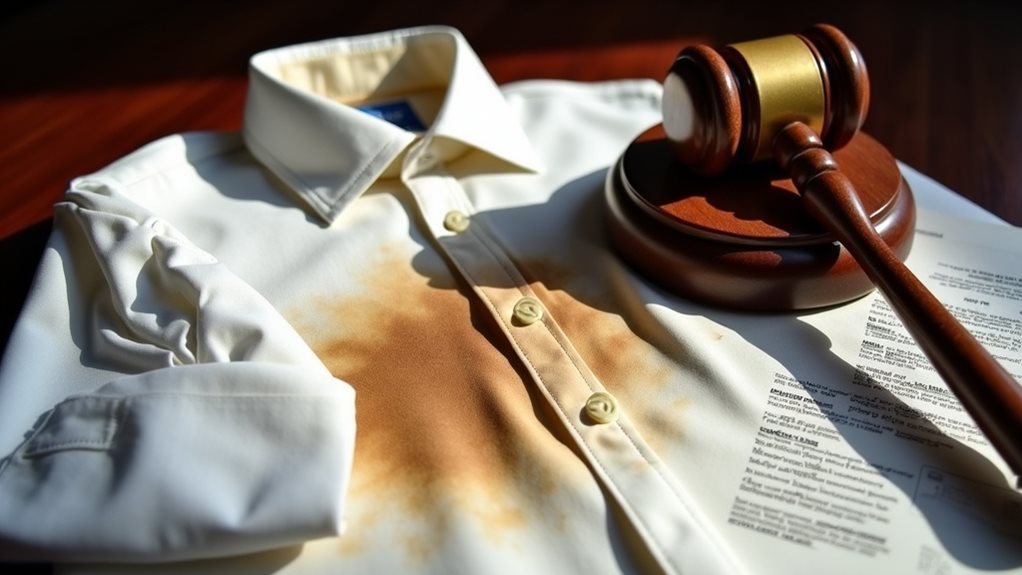When your dry cleaner damages or loses your clothes, you’re entitled to compensation based on current market value, not merely a dismissive “sorry, not our fault.” Document everything immediately with photos and your receipt, then demand fair compensation – those flimsy disclaimers they hide behind hold little legal weight. You can escalate complaints to trade associations, pursue mediation, or even file in small claims court if they refuse responsibility, and there’s a strategic approach that maximizes your chances of success.
Understanding Your Consumer Rights Under the Law
What happens when your favorite blazer comes back from the dry cleaner looking like it went through a blender, and you’re left wondering if you have any recourse beyond frustrated sighs? 😤
Well, here’s the thing – you’ve got more power than you think under the Consumer Rights Act 2015. Your dry cleaner must provide services with reasonable skill and care, and when they mess up through negligence, you can absolutely seek compensation for damaged items.
Don’t let them wave around those “not our fault” disclaimers either – they’re basically worthless legally. You’re entitled to the current market value, not what you originally paid, and if they won’t cooperate, escalate your consumer complaint to their trade association.
Beyond damage concerns, it’s worth noting that if your garments return with strong chemical odors from traditional solvents, allow them to air out properly before wearing to minimize any potential health risks from residual cleaning chemicals.
What to Do When Your Clothes Are Damaged or Lost

When disaster strikes and your clothes come back damaged or disappear entirely, your first move should be to march right back to the dry cleaner with your receipt in hand – and I mean immediately, not three weeks later when you finally get around to checking that garment bag.
I learned this the hard way when my wedding dress came back with mysterious yellow stains, and by the time I discovered them months later, the cleaner claimed they couldn’t determine if the damage happened on their watch.
Here’s your action plan when items go missing or get damaged:
Act fast when disaster strikes – document damage immediately and demand fair compensation before your window of opportunity closes.
- Report the problem immediately and document everything with photos
- Determine if damage stems from cleaner negligence or manufacturer defects
- Request compensation based on current market value, not original price
- Review the dry cleaner’s specific policies regarding lost items
- Consider filing complaints or pursuing small claims court if they refuse responsibility
Your claim’s success depends on swift action and proper documentation. Keep in mind that dry cleaners face significant operational costs from expensive chemical solvents, specialized equipment, and strict environmental regulations, which is why they often carry comprehensive insurance to handle damage claims.
How to File an Effective Complaint With Your Dry Cleaner

Although confronting a business about poor service feels intimidating, filing an effective complaint with your dry cleaner doesn’t require you to channel your inner Karen – it just demands a systematic approach that protects your interests while maintaining civility. 💼
I remember standing in my local cleaner’s lobby, clutching a silk blouse that looked like it had survived a paint bomb explosion, feeling my cheeks burn with embarrassment as other customers glanced over.
But I’d learned from previous mishaps that being organized and direct gets better results than emotional outbursts.
Contact your dry cleaner immediately when you discover lost or damaged items, clearly explaining what went wrong and what compensation you’re seeking.
Document communications thoroughly, noting dates, names, and conversations.
If they ignore proper cleaning instructions or your consumer rights, escalate your complaint to management with your documented evidence.
Even if you’ve misplaced your claim stub, bring valid identification and detailed descriptions of your items, as reputable establishments typically have systems to help verify your ownership.
Determining Who Is at Fault for Cleaning Mishaps

When your favorite silk blouse comes back looking like it survived a wrestling match with a steam iron, you’ll need to figure out whether the dry cleaner messed up or if the garment had issues from the start.
The key is understanding that damage can stem from various sources—sometimes it’s the cleaner’s fault for using harsh chemicals on delicate fabric, but other times the manufacturer’s sketchy care label or a hidden defect is the real culprit.
I learned this the hard way when my expensive cashmere sweater shrunk to toddler size, and after some detective work, we discovered the original store had attached completely wrong care instructions 😅.
Some items like beaded garments, activewear, and leather should never go through the dry cleaning process in the first place, as the chemical solvents can cause irreversible damage to these materials.
Identifying Damage Sources
Since damage can stem from multiple sources during the dry cleaning process, you’ll need to play detective to figure out who’s actually responsible for your ruined garment.
Think of yourself as investigating a mystery where the chemical solvent, handling procedures, or even the garment’s original condition could be the culprit.
Start documenting the garment’s condition before you hand it over – I learned this the hard way after losing a favorite blazer.
Here’s what to examine:
- Chemical damage from harsh solvents or incorrect cleaning instructions
- Mechanical damage from faulty equipment or rough handling
- Pre-existing flaws that weren’t visible initially
- Manufacturing defects that cleaning simply revealed
- Care label errors that led to inappropriate treatment
Additionally, be aware that traditional dry cleaning solvents like perchloroethylene can leave chemical residues on garments that may cause skin irritation or other health concerns if not properly aired out.
Establishing negligence versus unavoidable accidents determines your dry cleaner’s liability and whether you can claim compensation for damages or losses.
Liability Assessment Process
Once you’ve identified potential damage sources, the real challenge begins: figuring out who’s actually at fault, which can feel like maneuvering through a legal maze where everyone points fingers at someone else.
The liability assessment hinges on solid documentation—those before-and-after photos you hopefully took become your best friends in this process.
If you provided clear care instructions and your dry cleaner ignored them, causing damage to your garment, they’re typically on the hook.
However, if pre-existing stains or manufacturing defects caused the problem, liability shifts away from the cleaning professionals.
Communication plays a huge role here; dry cleaners must warn you about potential risks, and you must disclose any known issues beforehand to establish fair accountability.
Additionally, if you experience skin sensitivity or breathing issues after picking up your garments, the dry cleaner may bear responsibility if they failed to properly air out clothes treated with toxic solvents before returning them to customers.
Seeking Compensation and Alternative Dispute Resolution

How do you actually get your money back when your favorite sweater comes back looking like it went through a blender, or worse, doesn’t come back at all?
The dry cleaning company owes you compensation based on current market value, not what you originally paid.
Here’s your action plan:
- Gather documentation like receipts and photos showing the damage or items left behind
- Calculate fair compensation using current market prices for replacement items
- Document every conversation with the dry cleaning company for future reference
- Contact their trade association if direct negotiation fails to resolve the issue
- Consider alternative dispute resolution methods before heading to small claims court
Keep in mind that while dry cleaned clothes can get wet without permanent damage, improper handling of moisture during the cleaning process can lead to water spots, shrinkage, or color bleeding that may strengthen your compensation claim.
When to Take Legal Action Through Small Claims Court

When your attempts at negotiating with the dry cleaner have hit a brick wall, and you’re left staring at the remnants of what used to be your favorite blazer, small claims court becomes your next logical step.
This user-friendly legal avenue handles damaged clothing cases up to $2,500-$25,000, depending on your location, and you won’t need expensive attorneys dragging things out for months.
Start by completing a filing packet with incident details, compensation amount, and documentation like receipts and email exchanges.
While legal advice can help, the process is designed for regular folks like us to maneuver solo. After filing, you’ll serve the dry cleaner with complaint papers, then a judge will determine liability during your hearing.
It’s straightforward justice for your wardrobe casualties! 👔




